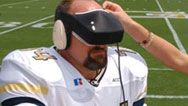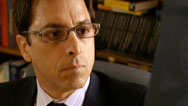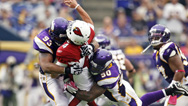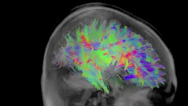Brain Trauma
- Posted 07.30.08
- NOVA scienceNOW
Knocks to the head may seem funny in cartoons, sports replays, and YouTube videos, but even minor head injuries often lead to serious concussions. A concussion may leave no trace on a conventional MRI scan yet cause permanent memory loss, attention problems, and depression. NOVA scienceNOW investigates promising new leads in understanding this puzzling condition, which affects millions of people in the U.S., including many high-school and college athletes who suffer concussions yet are encouraged to return to the playing field.
Transcript
BRAIN TRAUMA
PBS Airdate: July 30, 2008
NEIL DeGRASSE TYSON: Getting hit on the head is pretty much a guaranteed laugh in the world of cartoons, TV shows and movies. But in the real world, it's not so funny. And as correspondent John Torres reports, these days, we're finding out that even a seemingly minor head injury can cause a lot more damage than we ever thought.
JOHN TORRES: Reed Snyderman is 17. A high school junior, he plays varsity lacrosse and he's the U.S. Junior Olympic champion in freestyle skiing.
It was the last day of spring break, in 2008, when his trouble started.
REED SNYDERMAN: I was at the U.S. Nationals the end of, at the end of March. And I landed my top air, which was a back-flip iron cross. I was really aggressive, like, charging it, because I really wanted to go for it, you know? And I ended up just kind of catching my edge and kind of flipping and hitting my head and then being really bewildered and not really knowing what was going on.
SARAH SNYDERMAN (Reed Snyderman's Mother): His coach went over to him first and came back to me and said that he thought he was fine, except he might have a mild concussion.
JOHN TORRES: But Reed was not fine at all.
REED SNYDERMAN: I was really out of it. Everything's out of sync. It was really difficult for my brain to maintain a train of thought. It was definitely scary.
JOHN TORRES: Almost 4,000,000 athletes, boys and girls, suffer concussions every year. Many of them recover quickly. And a bang on the head is often considered just part of the game. You shake it off, and get back to the field as soon as possible. But for 20 percent of patients diagnosed with a concussion, recovery isn't so easy, because even when it's mild, a concussion is a traumatic brain injury.
JAM GHAJAR: If you look at traumatic brain injury, it is the number one cause of death and disability in young people.
JOHN TORRES: Jam Ghajar is a neurosurgeon at Weill Cornell Medical College in New York, and an international expert in brain injuries.
JAM GHAJAR: Ninety percent of traumatic brain injury is concussion. And how many numbers are we talking about? There are millions.
JOHN TORRES: But concussions are difficult to diagnose. They generally don't show up on a standard M.R.I., like the one I'm having now. So even if a patient has symptoms, understanding why is complicated.
Take a look at my M.R.I. compared to the M.R.I. of a concussion patient.
It looks normal.
JAM GHAJAR: They both look completely normal.
JOHN TORRES: But this one's not normal.
JAM GHAJAR: The patient has symptoms of mild traumatic brain injury. The neurologist would tell the patient, it looks normal to me. Your C.A.T. scan's normal, your M.R.I.'s normal.
So there's something else going on.
JOHN TORRES: M.R.I.s produce images of gray matter, cells called neurons and their connections, which make up most of the surface of the brain. Gray matter is organized into specific regions, which control functions like memory, speech, movement and coordination.
But a concussion doesn't usually do much damage to the gray matter. So now neurologists are searching for clues deeper within the brain, in the white matter.
MARILYN KRAUS (University of Illinois at Chicago): The white matter makes up the sort of cables or connections between the lobes or the sections of the brain.
JOHN TORRES: Those white matter connections are like telephone trunk lines. They bundle nerve cells from different areas of the brain into networks, which work together to produce and regulate thoughts and actions.
But if the white matter is damaged by a concussion, the connections could get disrupted, in theory, at least. Until recently, though, it was very difficult to see white matter on an M.R.I.
MARILYN KRAUS: To be able to really quantify and qualify the integrity of the white matter, you need to go to a specialized sequence like the D.T.I., or diffusion tensor imaging.
JOHN TORRES: D.T.I., or diffusion tensor imaging, is a new way to bring white matter out of the shadows, using advanced software to get more detailed information from an M.R.I. image.
DEBORAH LITTLE (University of Illinois at Chicago): When we bring up the D.T.I., you then can really clearly see where the white matter is and where the gray matter is, because, on this, white is white, gray matter is gray.
JOHN TORRES: It's not only the color that's important. White matter helps diffuse water through brain cells, and that may be an important clue to what goes wrong in concussions.
DEBORAH LITTLE: And so, with the D.T.I., all we're doing is looking at where water is, pretty much.
JOHN TORRES: So if the water is not flowing well, that tells you that there is some...
DEBORAH LITTLE: If you have a leak in the pipe, we're going to be able to pick that up with the D.T.I. If you compare the left and the right, you can see these two tracts clearly, here. But you can see, on this, you have the one on the outside, and the one on the inside is disrupted.
JOHN TORRES: One part of the brain can't talk to the other side of the brain, because it can't make it through that area.
DEBORAH LITTLE: Right.
JOHN TORRES: And that's what causes the impairment later on.
DEBORAH LITTLE: That's what we think. That's what our data shows, yes.
JOHN TORRES: Jam Ghajar agrees. His theory is that tiny tears in the white matter, caused by a concussion, disrupt the brain's natural timing, like a telephone conversation gone wrong.
JAM GHAJAR: One way for a normal person to feel like somebody with a concussion is to think of a cell phone conversation. Normally when you talk on the cell phone, you talk, the other person talks, you go back and forth, and it's smooth, but then, (silence), like my voice right there. You were expecting my voice to come in. It didn't come in, and you went...you got an error signal.
JOHN TORRES: Ghajar's theory is that microscopic tears in the white matter cause these error signals. They disrupt communication between different parts of the brain responsible for helping us to pay attention and remember what's going on around us.
JAM GHAJAR: There are populations of cells that communicate with each other and produce brain function. If you disrupt the connections between these areas, you disrupt attention and memory.
JOHN TORRES: To test this idea, I'm participating in an experiment Ghajar devised to measure a person's ability to pay attention.
This device records how well my eyes stay in sync with a moving target.
So these cameras are watching where my eyes are moving?
TECHNICIAN: Yes.
JAM GHAJAR: We picked eye movements in terms of following a predictable target. And you can't drive your eyes in a circle automatically. You have to pay attention to the target when it's going around.
JOHN TORRES: For most people, this test is easy. My eyes follow the target with no break in the cycle. But for someone who has symptoms after a concussion, it's a different story.
Ten years ago, artist Ann Schenpf suffered a concussion in a car accident. Even after intense therapy, she still has problems with speech, memory and attention.
ANN SCHNEPF (Concussion Patient): The first day that I went into my studio, I looked at my materials, and I couldn't figure out what to do with them. Like, I would pick up my...excuse me, I'm having trouble with words.
JOHN TORRES: Words for familiar things don't always come easily.
Like the paint.
ANN SCHNEPF: The paint, yeah. Like, I didn't remember what I did with it, even though I looked around my studio, and I could see my current painting that I was working on. So I turned around, and I walked out. I'm still, 10 years later, having a lot of those difficulties.
JOHN TORRES: When Ann tries the eye tracking test, it's a struggle.
JAM GHAJAR: What's happening with her is she's constantly having to start over again, and she's losing her train of thought. So here's a very predictable target. It's going around like this. My brain should be able to know it's going around like this and where the dot's going to be next. A head-injured patient is just wobbly all over it. They're trying to synchronize the dot. Their timing is off, and as a consequence, they've got this variability, which is directly proportional to how good their attention is.
RORY MORTON (Buckingham Browne & Nichols School): Good hit, good hit.
JOHN TORRES: For young athletes, problems with attention after a concussion can go way beyond the playing field.
REED SNYDERMAN: Definitely during school, I would like, I would lose the entire class, and I would lose the entire discussion in my classes. And math was impossible for that week, and I'm usually a really strong math student, so it was really strange.
RORY MORTON: Reed, that stick belongs below the shoulders...
Someone who's had a concussion may look like they should be able to participate. But they're not really aware of what they're doing at all. So that's a scary thought.
JOHN TORRES: But the most scary thought is sending a student who's had a concussion back into the game. This can happen, because there's no way to objectively diagnose concussions on the sidelines, and young athletes most often don't want to be benched.
But what if there were a tool to quickly and accurately assess if a brain injury has taken place? That's Jam Ghajar's next goal. He's developing a small, portable version of the eye tracking system I tried in the lab. Ann helped demonstrate how it might work.
JAM GHAJAR: So it's like a pair of regular glasses, and I'll cinch it up here a little bit. How's that feel?
ANN SCHNEPF: Comfortable.
JAM GHAJAR: Good. Okay.
JOHN TORRES: The same moving circle is projected directly on to the lens of this specially designed pair of glasses. Then a miniature camera records how well the eyes follow it. It's a quick way to tell if a concussion has taken place, impairing the brain's ability to pay attention to what's happening on the field.
RORY MORTON: Let's go, let's go.
JOHN TORRES: And that's an essential piece of information, because an athlete who's had one concussion is at high risk for another.
JAM GHAJAR: The person who's got poor attention, you don't want to send them back into play. Send them back in, they are unable to pay attention, and they get another injury. And you keep on adding those concussions together, then you see things like dementia and so on later in life.
JOHN TORRES: Ghajar's theory is still being tested. But the potential to diagnose concussions quickly and accurately is an appealing idea to Reed's coach.
RORY MORTON: It would just take all of the risk out of the equation. Something that is able to confirm a trauma to the brain, that takes the conjecture out of everyone's hands and says, "This is what we have to do."
JOHN TORRES: Six weeks after his concussion, Reed has made a full recovery. But the experience stays with him every time he heads onto the field or the slopes.
REED SNYDERMAN: I think a concussion is one of the scariest injuries that you can get. Like, I mean, when you break your arm, you're still you. You still can think, you still can, you know, you can still function fine. But when you hurt your brain, even when it's minor, even when it's not major, it's like you're not you for awhile, and that's definitely frightening.
Credits
Brain Trauma
- Edited by
- Nathan Hendrie
- Produced and Directed by
- Elizabeth Arledge
NOVA scienceNOW
- Executive Producer
- Samuel Fine
- Executive Editor
- Neil deGrasse Tyson
- Senior Series Producer
- Vincent Liota
- Supervising Producers
- Stephen Sweigart
Joey David - Editorial Producer
- Julia Cort
- Development Producer
- Vinita Mehta
- Senior Editor and Colorist
- David Chmura
- Online Editor
- Laura Raimondo
- Series Production Assistant
- Fran Laks
- Assistant Editors
- Susan Perla
Tung-Jen (Sunny) Chiang - Compositors
- Brian
Edgerton
Yunsik Noh - Music
- Rob Morsberger
- NOVA scienceNOW Series Animation
- Edgeworx
- Additional Editing For Mammoth Mystery Segment
- Gary Hochman
- Additional Producing for Phoenix Mars Lander Segment
- Joseph McMaster
- Field Producer For Phoenix Mars Lander Segment
- Anna Lee Strachan
- Associate Producers
- Fran
Laks
Jonathan Loewald
Molly Longstreth
Alison Snyder - Camera
- John Baynard
Brian Dowley
Joe Friedman
Tim Gibbons
Terry Hatch
Max Miller
Brian Seifferlein - Sound Recordists
- John Cameron
Michael Cottrell
Bruce Engler
Tyler Lang
James M. Lenertz
Charlie Macarone
John O'Connor - Sound Mix
- David Chmura
- Animation
- Scott
Beachler
Thomas Floyd
Anthony Kraus
Sputnik Animation
James Laplante
3FX - Assistant Editors for Phoenix Mars Lander segment
- Evelyn
Carrigan
Tyler H. Walk - Production Assistant
- Elizabeth Stachow
- Three dimensional brain animation
- Courtesy Dr. Arthur W. Toga, Laboratory of Neuro Imaging at UCLA
- Archival Material
- BBC Gallery
JPL-Caltech
The Alan Mason Chesney Medical Archives of The Johns Hopkins Medical Institutions
NASA
Plimpton Collection, Rare Book and Manuscript Library, Columbia University
Sveriges Television
Texas A&M University
University of Arizona
University of Nebraska State Museum - Special Thanks
- John Beck
Children's Hospital Boston
Donald Edwards
Sara Hammond
Massachusetts Eye and Ear Infirmary
Trailside Museum - Neil deGrasse Tyson
- is director of the Hayden Planetarium in the Rose Center for Earth and Space at the American Museum of Natural History.
- NOVA scienceNOW Consortium Stations
- Nebraska
Educational Telecommunications, NET
Public Broadcasting for Northern California, KQED
Twin Cities Public Television, TPT
Wisconsin Public Television, WPT - NOVA Series Graphics
- yU + co.
- NOVA Theme Music
- Walter Werzowa
John Luker
Musikvergnuegen, Inc. - Additional NOVA Theme Music
- Ray Loring
Rob Morsberger - Post Production Online Editor
- Spencer Gentry
- Closed Captioning
- The Caption Center
- Publicity
- Carole McFall
Eileen Campion
Lindsay de la Rigaudiere
Victoria Louie
Kate Becker - Senior Researcher
- Gaia Remerowski
- Production Coordinator
- Linda Callahan
- Paralegals
- Raphael Nemes
Sarah Erlandson - Talent Relations
- Scott Kardel, Esq.
Janice Flood - Legal Counsel
- Susan Rosen
- Post Production Assistant
- Darcy Forlenza
- Associate Producer, Post Production
- Patrick Carey
- Post Production Supervisor
- Regina O'Toole
- Post Production Editors
- Rebecca Nieto
Alex Kreuter - Post Production Manager
- Nathan Gunner
- Compliance Manager
- Linzy Emery
- Development Producer
- Pamela Rosenstein
- Business Manager
- Joseph P. Tracy
- Senior Producer and Project Director
- Lisa Mirowitz
- Coordinating Producer
- Laurie Cahalane
- Senior Science Editor
- Evan Hadingham
- Senior Series Producer
- Melanie Wallace
- Managing Director
- Alan Ritsko
- Senior Executive Producer
- Paula S. Apsell
This material is based upon work supported by the National Science Foundation under Grant No. 0638931. Any opinions, findings, and conclusions or recommendations expressed in this material are those of the author(s) and do not necessarily reflect the views of the National Science Foundation.
NOVA scienceNOW is a trademark of the WGBH Educational Foundation
NOVA scienceNOW is produced for WGBH/Boston by NOVA
© 2008 WGBH Educational Foundation
All rights reserved
- Image credit: (brain model) © Michael Prince/Corbis
Participants
- Jamshid Ghajar
- President, Brain Trauma Foundation www.ghajar.net/
- Marilyn Kraus
- University of Illinois at Chicago
- Deborah Little
- University of Illinois at Chicago ccm.psych.uic.edu/People/Investigators/little.aspx
- Rory Morton
- Buckingham Browne & Nichols School
- Ann Schnepf
- Reed Snyderman
- Sarah Snyderman
- Reed's mom
- John Torres
- Correspondent
Sources
Links
Brain Trauma Foundation
www.braintrauma.org
Find out more about the work of Jam Ghajar and his colleagues on this site, and view a fact sheet about the millions of Americans affected by brain injuries.
Medline Plus: Head and Brain Injuries
www.nlm.nih.gov/medlineplus/headandbraininjuries.html
Learn about the symptoms, treatment, and physiology of brain trauma.
Independent Lens: Traumatic Brain Injury
www.pbs.org/independentlens/lossofnamelessthings/tbi.html
This companion page to the PBS film "The Loss of Nameless Things" offers some quick facts about TBI and resources for further research.
PBS: The Secret Life of the Brain
www.pbs.org/wnet/brain/index.html
This page provides a look at the way our brains change from infancy through adulthood, plus a 3-D tour of the brain's anatomy, optical illusions, and more.
Books
Head Cases: Stories of Brain Injury and Its Aftermath
by Michael Paul Mason. Farrar, Straus, and Giroux, 2008.
Brain Injury Survivor's Guide
by Beth and Larry Jameson. Outskirts Press, 2007.
Traumatic Brain Injury: Rehabilitative Treatment and Case Management
edited by Mark Ashley. CRC Press, 2004.
Textbook of Traumatic Brain Injury
edited by Stuart Yudofsky, Jonathan Silver, and Thomas McAllister. American Psychiatric, 2004.
Neurotrauma: Evidence-Based Answers to Common Questions
by Donald Becker, Alex Valadka et al. Thieme, 2004.
Articles
"Nutritional Support Linked to Lower Brain Trauma Mortality"
by Charles Bankhead. Medpage Today, July 2, 2008.
www.medpagetoday.com/Surgery/Neurosurgery/tb/10010
"Cellular 'Puncture Repair Kit' May Minimize Brain Trauma"
by Lucas Laursen. Nature, June 30, 2008.
"Stress and Coping Among Families of Patients with Traumatic Brain Injury"
by S. Verhaeghe, T. Defloor, and M. Grypdonck. Journal of Clinical Nursing, Vol. 14, Issue 8, 1004-1012, 2005.
"Eye-Target Synchronization in Mild Traumatic Brain Injured Patients"
by R. Contreras, Jamshid Ghajar et al. J Biological Physics, 2008.
Related Links
-

Diagnosing Brain Damage
New techniques can assess concussions and other head injuries, some directly on the playing field.
-

Brain Trauma: Expert Q&A
Neurosurgeon Jam Ghajar answers questions about preventing and treating concussions and more severe brain injuries.
-

A Preventable Brain Disease
Athletes who receive multiple concussions are at risk for CTE, a brain disease that causes cognitive impairment.
-

Mapping the Brain
Use some of the same imaging techniques neuroscientists use—from MRIs to PET scans—to see inside the huma...



